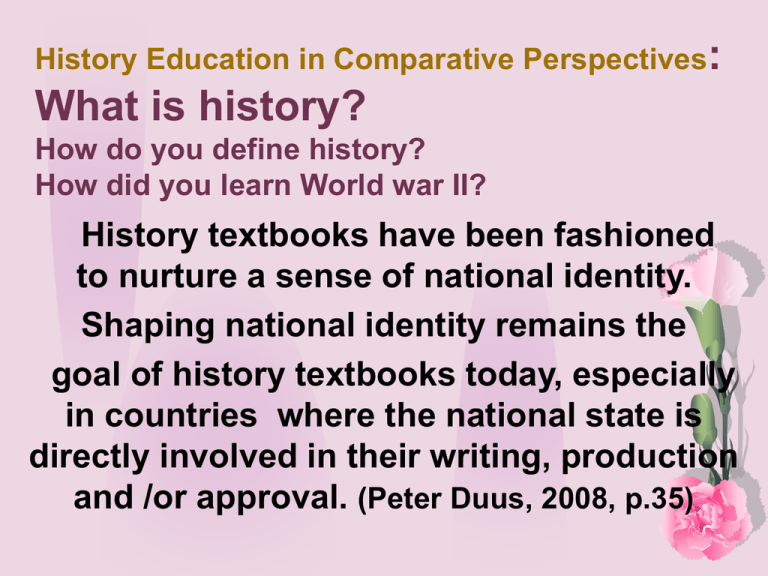History Education in Comparative Views
advertisement

History Education in Comparative Perspectives: What is history? How do you define history? How did you learn World war II? History textbooks have been fashioned to nurture a sense of national identity. Shaping national identity remains the goal of history textbooks today, especially in countries where the national state is directly involved in their writing, production and /or approval. (Peter Duus, 2008, p.35) National Identities Among British, German and Japanese University Students 2005, 2006 “German identity is a strong awareness of historical responsibility”. (German student of Bochum university, Germany Age 21) *Being British is the ability to live in harmony with people of all nationalities with respect for the cultural roots of all those who choose to be or are British citizens. (A Scottish student of Leeds University, UK, Age 22 ) *German national identity lies in history influenced by the past (World War II) and the lessons to learn from these events. Our identity is a strong awareness of historical responsibility (A German student of Bochum University, Age 21) We can learn the value of peace from our tragic history. We must pass the lesson of our history on to the next generation. (A Japanese student of Konan University, Age 21) The issues of History textbooks Historical objectivity History books can never be objective. How much can history textbook “factually accurate”? Vocabularies and expressions used in textbooks to describe or characterize events are different from country to country. Ex. In 1982 The ministry of Education of the Japanese government tried to substitute the word “advance” for the word “invasion” in textbook account of the war in China. Criticism from neighboring countries persuaded the Japanese government to be more sensitive to the feelings of neighboring countries. Asian-Pacific War in Japan (Japan) アジア太平洋戦争 Anti-Japanese Pacific War (China) 抗日戦争 World War II (1941-1945) (USA) 第二次世界大戦 Nanking Incident (Japan) 南京事件 Nanking massacre (China) 南京虐殺 The aim of history education History education influences on nurturing a sense of national identity By articulating a particular view of national identity, the textbook aims at turning the young people into “good citizens” in US. The mission of Korean history is, through a revealing of the real nature of our national spirit and life, to establish our nation’s true character. In Japan, emphasis is placed on efforts to “develop friendly and cooperative relations with neighboring countries and to contribute to the peace and stability of Asia, and in turn, of the world. (Duus, 2008) View of History Hegel’s view of history Marxist view of history The Enlightenment view of history Difficulty of writing a transnational common history of modern East Asia American attempts to create a global hegemony for the sake of democracy and free world during World War II, Cold war, and War in Iraq. History textbooks in USA In the United States, where textbook production and textbook markets are not regulated by the central government, the politics of history textbook publishing are different from China, Japan and Korea. The event that finally propels the country toward maturity is Japan’s “Hara-kiri” gamble in Hawaii”– the attack on Pearl Harbor. This event instantly forges national unity behind a declaration of war even though most Americans have no idea why the attack took place. The story told in The American Pageant appears is a standard narrative found in many American history textbooks. It is a story that reflects both the liberal internationalism and the conservative interventionism that dominated American policy in the decades following the war. Authors and publishers are less committed to reproducing an official version of national history than to responding to shifts in public opinion. To put it another way, perhaps crudely, “civil society” plays a greater role in the production of history textbooks than the national state does. (Duus, 2008) History Textbooks in China (PRC means People Republic of China) The 2003 PRC textbook describes the Japanese decision to surrender as a response to the Soviet declaration of war and Mao’s call for an all-out attack on Japanese forces. The 2007 version is likewise silent about any Allied participation in the war aside from the cooperation of British, American and Chinese in Burma in early 1945. The 2003 PRC textbook explains the origins of the war as the result of the imperialist economic rivalry between Japan and the United States. In the revised 2007 PRC textbook the “monstrous crimes of the Japanese military” proportionally occupy more space than in the 2003 version. A story of resistance and liberation that ends with the triumph of the Chinese people/nation –can affirm national identity in quite different political contexts. (Duus, 2008) History textbooks in Japan In contrast to American and Chinese textbooks Japanese history text books offer no strong narrative about the war. The Japanese textbooks make no attempt to glorify or justify the war, to portray Japan as the “victim” of outside forces, or to offer an apologia for wartime atrocities (Duus, 2008) Duss’s conclusion Duus (2008) concluded that a majority of Japanese agree that Japan waged a war of aggression in Asia and that it inflicted great harm on the Asian people. Having experienced a disastrous defeat, the Japanese public, much to the consternation of some of their leaders, remains pacifist in orientation. The problem is not so much the “facts” on which there seems to be rough kind of agreement, but the “words” and “stories.” As long as the definition of national identity remains at the center of textbook writing, the possibilities for the production of joint history remains limited. (Duus, 2008) References War Stories (2008) by Peter Duus, William H. Bonsall Professor of History, Emeritus, Stanford University Divided Memories and reconciliation: A progress Report (2008) by Daniel C. Sneider, Associate Director for Research, Shorenstein APARC, Stanford University.



